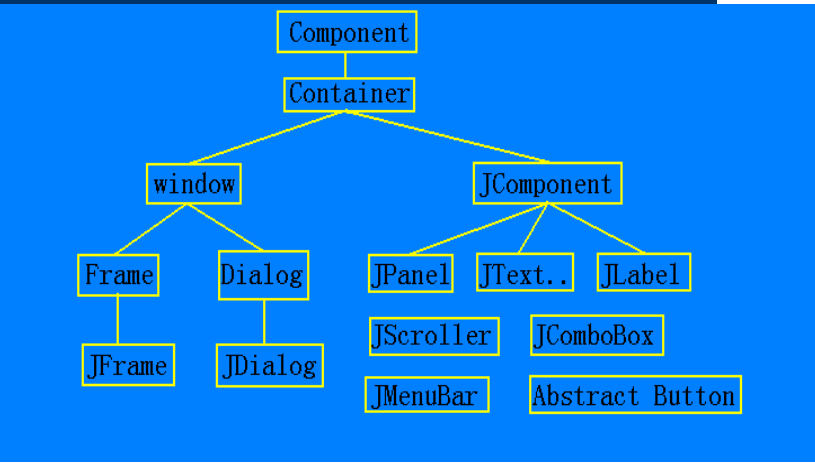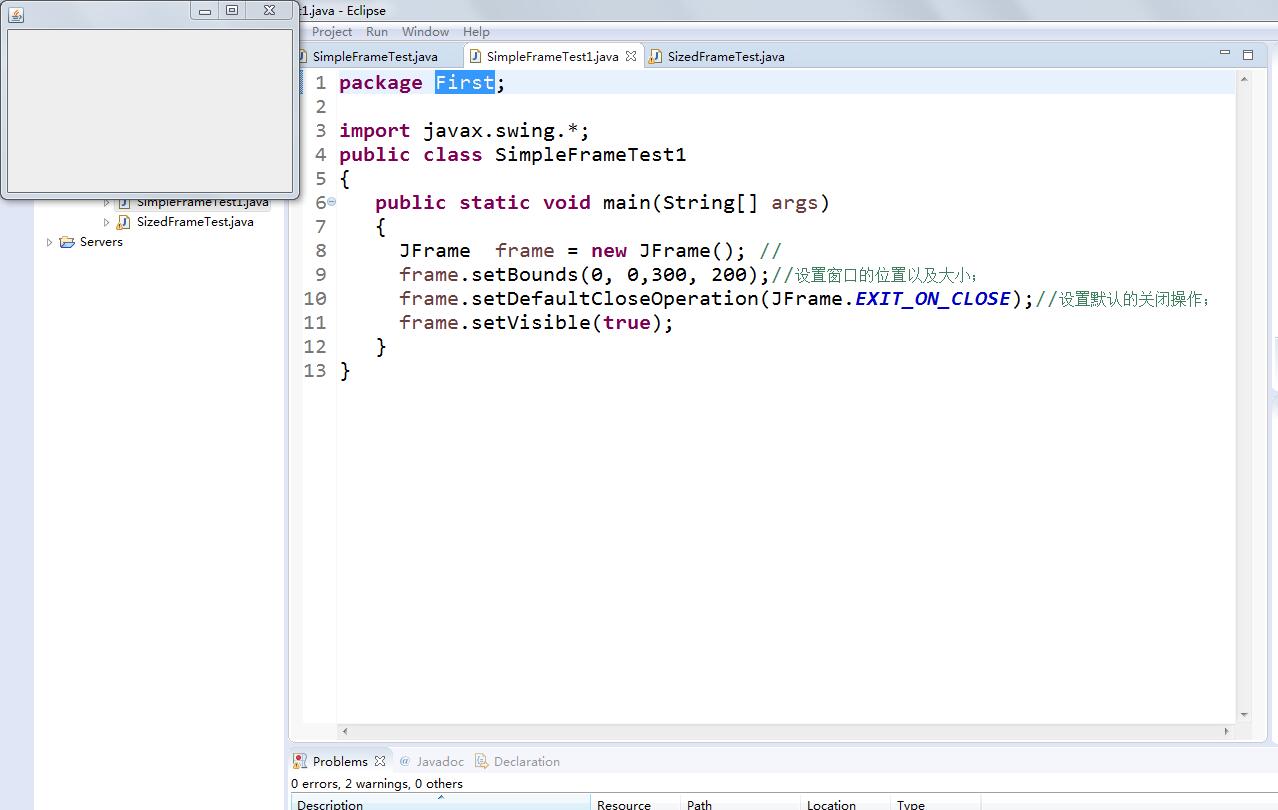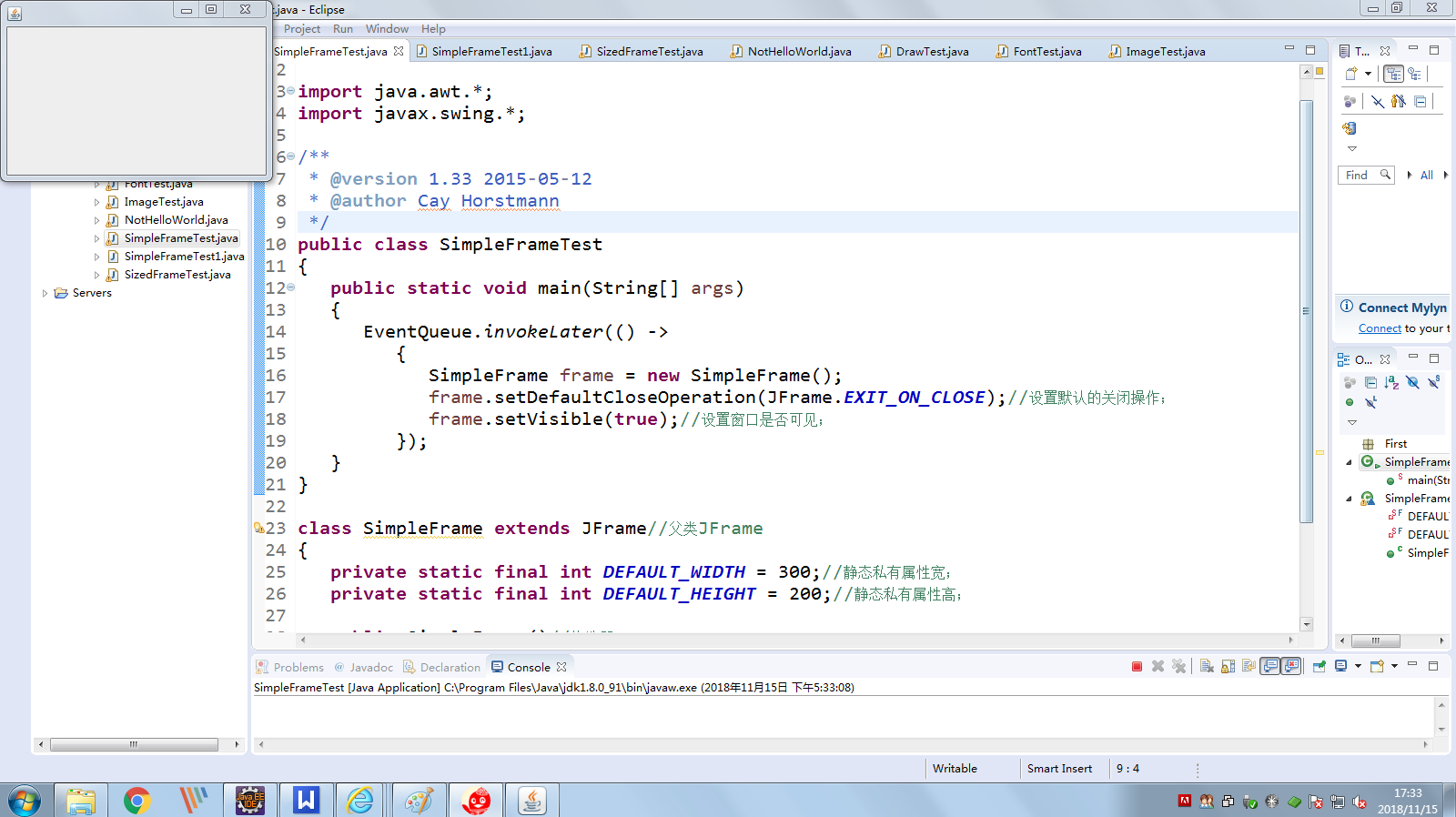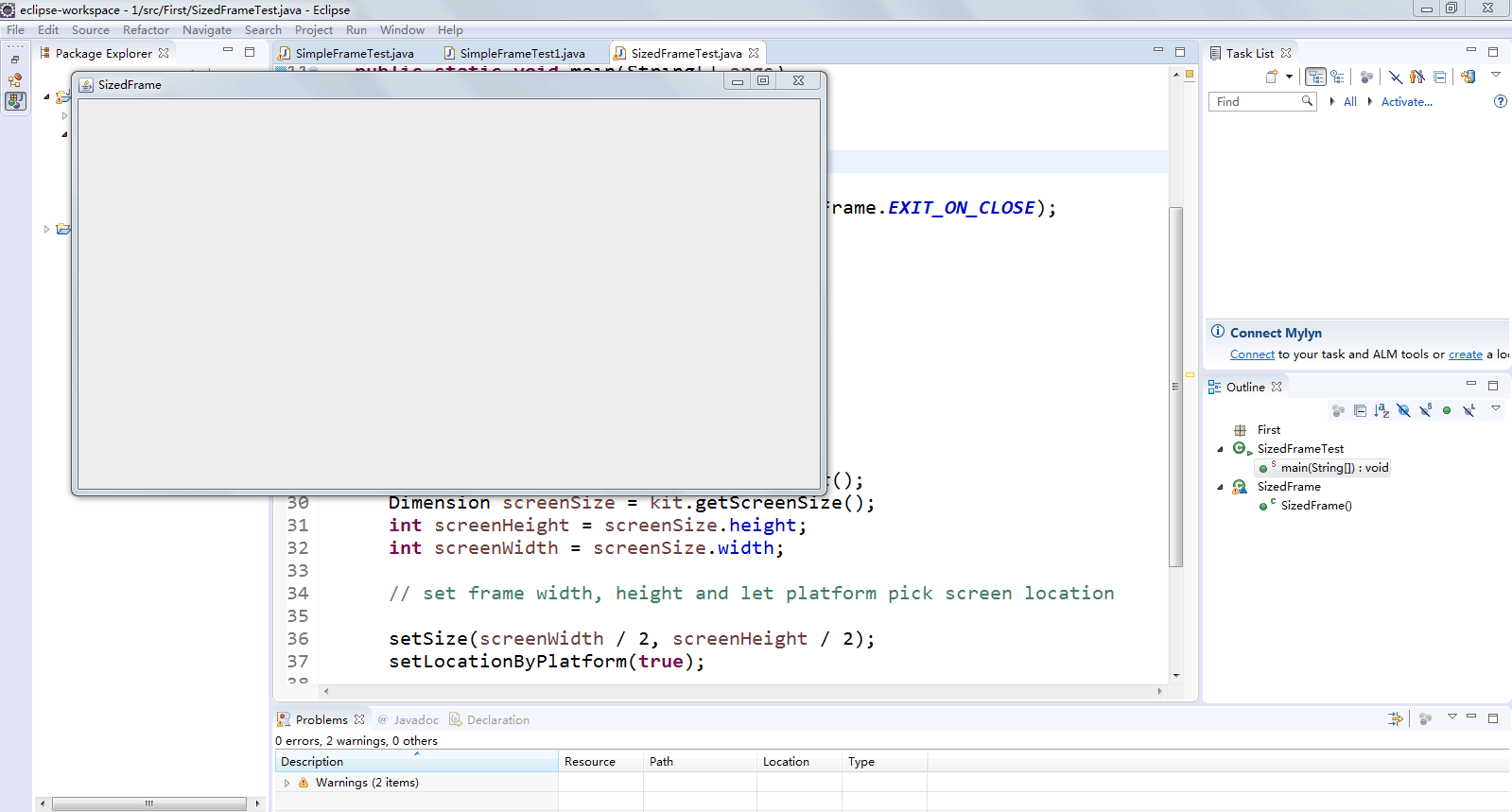第十二周学习总结
第一部分:理论知识
内容概要: AWT与Swing简介;框架的创建;图形程序设计; 显示图像;
1.AWT组件:

2.Swing 组件层次关系

3 .AWT与Swing的关系:大部分AWT组件都有其Swing的等价组件; Swing组件的名字一般是在AWT组件名前面添加一个字母“J”,如:JButton,JFrame,JPanel等。
4.组件:通常把由Component类的子类或间接子类创建的对象称为一个组件。 例:Button button = new Button();TextField textField = new TextField();Label label = new Label();
5.组件类的常用API
java.awt.Component 1.0
– boolean isVisible() 检查组件是否可见
– void setVisible(boolean b) 设置组件可见
– void setSize(int width,int height) 把组件缩放到指定宽度和高度
– void setBounds(int x,int y,int width,int height) 移动并缩放组件
– Dimension getSize() 得到组件的大小
– void setSize(Dimension d) 把组件缩放到指定的大小
– void setLocation(int x,int y)
6.容器:容器是Java中能容纳和排列组件的组件。 常用的容器是框架(Frame,JFrame)例:Frame fra = new Frame(“这是一个窗口”);
7. java.awt.Frame 类的常用API
void setResizable(boolean b) 缩放框架
void setTitle(String s) 设置框架标题
void setIconImage(Image image) 将Image用作框架图标
8.添加组件
(1)Container类提供了一个方法add(),用来在容器类组件对象中添加其他组件。
(2) 容器本身也是一个组件,可以把一个容器添加到另一个容器里,实现容器嵌套。
9.框架(Frame)的创建
(1)创建空框架:在Java中,常采用框架(Frame)创建初始界面,即GUI的顶层窗口
(2)AWT库中有一个基于对等体的Frame类;该类的Swing版本为JFrame,JFrame是Frame子类。
第二部分:实验部分
实验十二 图形程序设计
实验时间 2018-11-14
1、实验目的与要求
(1) 掌握Java GUI中框架创建及属性设置中常用类的API;
(2) 掌握Java GUI中2D图形绘制常用类的API;
(3) 了解Java GUI中2D图形中字体与颜色的设置方法;
(4) 了解Java GUI中2D图像的载入方法。
2、实验内容和步骤
实验1: 导入第10章示例程序,测试程序并进行代码注释。
测试程序1:
l 运行下列程序,观察程序运行结果。
|
import javax.swing.*; public class SimpleFrameTest { public static void main(String[] args) { JFrame frame = new JFrame(); frame.setBounds(0, 0,300, 200); frame.setDefaultCloseOperation(JFrame.EXIT_ON_CLOSE); frame.setVisible(true); } } |
1 package First; 2 3 import javax.swing.*; 4 public class SimpleFrameTest1 5 { 6 public static void main(String[] args) 7 { 8 JFrame frame = new JFrame(); 9 frame.setBounds(0, 0,300, 200);//设置窗口的位置(0,0)以及大小(宽高); 10 frame.setDefaultCloseOperation(JFrame.EXIT_ON_CLOSE);//设置默认的关闭操作; 11 frame.setVisible(true); //boolean设置窗口是否可见; 12 } 13 }

E]SJ5TC~F8)X.jpg)
l 在elipse IDE中调试运行教材407页程序10-1,结合程序运行结果理解程序;与上面程序对比,思考异同;
l 掌握空框架创建方法;
l 了解主线程与事件分派线程概念;
l 掌握GUI顶层窗口创建技术。
1 package First; 2 3 import java.awt.*; 4 import javax.swing.*; 5 6 /** 7 * @version 1.33 2015-05-12 8 * @author Cay Horstmann 9 */ 10 public class SimpleFrameTest 11 { 12 public static void main(String[] args) 13 { 14 EventQueue.invokeLater(() -> 15 { 16 SimpleFrame frame = new SimpleFrame(); 17 frame.setDefaultCloseOperation(JFrame.EXIT_ON_CLOSE);//设置默认的关闭操作; 18 frame.setVisible(true);//设置窗口是否可见; 19 }); 20 } 21 } 22 23 class SimpleFrame extends JFrame//父类JFrame 24 { 25 private static final int DEFAULT_WIDTH = 300;//静态私有属性宽; 26 private static final int DEFAULT_HEIGHT = 200;//静态私有属性高; 27 28 public SimpleFrame()//构造器 29 { 30 setSize(DEFAULT_WIDTH, DEFAULT_HEIGHT); 31 } 32 }

测试程序2:
l 在elipse IDE中调试运行教材412页程序10-2,结合程序运行结果理解程序;
l 掌握确定框架常用属性的设置方法。
1 package First; 2 import java.awt.*; 3 import javax.swing.*; 4 5 /** 6 * @version 1.34 2015-06-16 7 * @author Cay Horstmann 8 */ 9 public class SizedFrameTest 10 { 11 public static void main(String[] args) 12 { 13 EventQueue.invokeLater(() -> 14 { 15 JFrame frame = new SizedFrame(); 16 frame.setTitle("SizedFrame"); 17 frame.setDefaultCloseOperation(JFrame.EXIT_ON_CLOSE); 18 frame.setVisible(true); 19 }); 20 } 21 } 22 23 class SizedFrame extends JFrame 24 { 25 public SizedFrame() 26 { 27 // get screen dimensions 28 29 Toolkit kit = Toolkit.getDefaultToolkit(); 30 Dimension screenSize = kit.getScreenSize(); 31 int screenHeight = screenSize.height; 32 int screenWidth = screenSize.width; 33 34 // set frame width, height and let platform pick screen location 35 36 setSize(screenWidth / 2, screenHeight / 2); 37 setLocationByPlatform(true); 38 39 // set frame icon 40 41 Image img = new ImageIcon("icon.gif").getImage(); 42 setIconImage(img); 43 } 44 }

测试程序3:
l 在elipse IDE中调试运行教材418页程序10-3,结合运行结果理解程序;
l 掌握在框架中添加组件;
l 掌握自定义组件的用法。
1 package First; 2 3 import javax.swing.*; 4 import java.awt.*; 5 6 /** 7 * @version 1.33 2015-05-12 8 * @author Cay Horstmann 9 */ 10 public class NotHelloWorld 11 { 12 public static void main(String[] args) 13 { 14 EventQueue.invokeLater(() -> 15 { 16 JFrame frame = new NotHelloWorldFrame(); 17 frame.setTitle("NotHelloWorld"); 18 frame.setDefaultCloseOperation(JFrame.EXIT_ON_CLOSE); 19 frame.setVisible(true); 20 }); 21 } 22 } 23 24 /** 25 * A frame that contains a message panel 26 */ 27 class NotHelloWorldFrame extends JFrame 28 { 29 public NotHelloWorldFrame() 30 { 31 add(new NotHelloWorldComponent()); 32 pack(); 33 } 34 } 35 36 /** 37 * A component that displays a message. 38 */ 39 class NotHelloWorldComponent extends JComponent 40 { 41 public static final int MESSAGE_X = 75; 42 public static final int MESSAGE_Y = 100; 43 44 private static final int DEFAULT_WIDTH = 300; 45 private static final int DEFAULT_HEIGHT = 200; 46 47 public void paintComponent(Graphics g) 48 { 49 g.drawString("Not a Hello, World program", MESSAGE_X, MESSAGE_Y); 50 } 51 52 public Dimension getPreferredSize() { return new Dimension(DEFAULT_WIDTH, DEFAULT_HEIGHT); } 53 }

测试程序4:
l 在elipse IDE中调试运行教材424 -425页程序10-4,结合程序运行结果理解程序;
l 掌握2D图形的绘制方法。
1 package First; 2 3 import java.awt.*; 4 import java.awt.geom.*; 5 import javax.swing.*; 6 7 /** 8 * @version 1.33 2007-05-12 9 * @author Cay Horstmann 10 */ 11 public class DrawTest 12 { 13 public static void main(String[] args) 14 { 15 EventQueue.invokeLater(() -> 16 { 17 JFrame frame = new DrawFrame(); 18 frame.setTitle("DrawTest"); 19 frame.setDefaultCloseOperation(JFrame.EXIT_ON_CLOSE); 20 frame.setVisible(true); 21 }); 22 } 23 } 24 25 /** 26 * A frame that contains a panel with drawings 27 */ 28 class DrawFrame extends JFrame 29 { 30 public DrawFrame() 31 { 32 add(new DrawComponent()); 33 pack(); 34 } 35 } 36 37 /** 38 * A component that displays rectangles and ellipses. 39 */ 40 class DrawComponent extends JComponent 41 { 42 private static final int DEFAULT_WIDTH = 400; 43 private static final int DEFAULT_HEIGHT = 400; 44 45 public void paintComponent(Graphics g) 46 { 47 Graphics2D g2 = (Graphics2D) g; 48 49 // draw a rectangle 50 51 double leftX = 100; 52 double topY = 100; 53 double width = 200; 54 double height = 150; 55 56 Rectangle2D rect = new Rectangle2D.Double(leftX, topY, width, height); 57 g2.draw(rect); 58 59 // draw the enclosed ellipse 60 61 Ellipse2D ellipse = new Ellipse2D.Double(); 62 ellipse.setFrame(rect); 63 g2.draw(ellipse); 64 65 // draw a diagonal line 66 67 g2.draw(new Line2D.Double(leftX, topY, leftX + width, topY + height)); 68 69 // draw a circle with the same center 70 71 double centerX = rect.getCenterX(); 72 double centerY = rect.getCenterY(); 73 double radius = 150; 74 75 Ellipse2D circle = new Ellipse2D.Double(); 76 circle.setFrameFromCenter(centerX, centerY, centerX + radius, centerY + radius); 77 g2.draw(circle); 78 } 79 80 public Dimension getPreferredSize() { return new Dimension(DEFAULT_WIDTH, DEFAULT_HEIGHT); } 81 }

测试程序5:
l 在elipse IDE中调试运行教材432页-433程序10-5,结合程序运行结果理解程序;
l 了解2D图形中字体的设置的方法;
1 package First; 2 3 import java.awt.*; 4 import java.awt.font.*; 5 import java.awt.geom.*; 6 import javax.swing.*; 7 8 /** 9 * @version 1.34 2015-05-12 10 * @author Cay Horstmann 11 */ 12 public class FontTest 13 { 14 public static void main(String[] args) 15 { 16 EventQueue.invokeLater(() -> 17 { 18 JFrame frame = new FontFrame(); 19 frame.setTitle("FontTest"); 20 frame.setDefaultCloseOperation(JFrame.EXIT_ON_CLOSE); 21 frame.setVisible(true); 22 }); 23 } 24 } 25 26 /** 27 * A frame with a text message component 28 */ 29 class FontFrame extends JFrame 30 { 31 public FontFrame() 32 { 33 add(new FontComponent()); 34 pack(); 35 } 36 } 37 38 /** 39 * A component that shows a centered message in a box. 40 */ 41 class FontComponent extends JComponent 42 { 43 private static final int DEFAULT_WIDTH = 300; 44 private static final int DEFAULT_HEIGHT = 200; 45 46 public void paintComponent(Graphics g) 47 { 48 Graphics2D g2 = (Graphics2D) g; 49 50 String message = "Hello, World!"; 51 52 Font f = new Font("Serif", Font.BOLD, 36); 53 g2.setFont(f); 54 55 // measure the size of the message 56 57 FontRenderContext context = g2.getFontRenderContext(); 58 Rectangle2D bounds = f.getStringBounds(message, context); 59 60 // set (x,y) = top left corner of text 61 62 double x = (getWidth() - bounds.getWidth()) / 2; 63 double y = (getHeight() - bounds.getHeight()) / 2; 64 65 // add ascent to y to reach the baseline 66 67 double ascent = -bounds.getY(); 68 double baseY = y + ascent; 69 70 // draw the message 71 72 g2.drawString(message, (int) x, (int) baseY); 73 74 g2.setPaint(Color.LIGHT_GRAY); 75 76 // draw the baseline 77 78 g2.draw(new Line2D.Double(x, baseY, x + bounds.getWidth(), baseY)); 79 80 // draw the enclosing rectangle 81 82 Rectangle2D rect = new Rectangle2D.Double(x, y, bounds.getWidth(), bounds.getHeight()); 83 g2.draw(rect); 84 } 85 86 public Dimension getPreferredSize() { return new Dimension(DEFAULT_WIDTH, DEFAULT_HEIGHT); } 87 }

测试程序6:
l 在elipse IDE中调试运行教材436页-437程序10-6,结合程序运行结果理解程序;
l 了解2D图形图像的显示方法。
1 package First; 2 3 import java.awt.*; 4 import javax.swing.*; 5 6 /** 7 * @version 1.34 2015-05-12 8 * @author Cay Horstmann 9 */ 10 public class ImageTest 11 { 12 public static void main(String[] args) 13 { 14 EventQueue.invokeLater(() -> 15 { 16 JFrame frame = new ImageFrame(); 17 frame.setTitle("ImageTest"); 18 frame.setDefaultCloseOperation(JFrame.EXIT_ON_CLOSE); 19 frame.setVisible(true); 20 }); 21 } 22 } 23 24 /** 25 * A frame with an image component 26 */ 27 class ImageFrame extends JFrame 28 { 29 public ImageFrame() 30 { 31 add(new ImageComponent()); 32 pack(); 33 } 34 } 35 36 /** 37 * A component that displays a tiled image 38 */ 39 class ImageComponent extends JComponent 40 { 41 private static final int DEFAULT_WIDTH = 300; 42 private static final int DEFAULT_HEIGHT = 200; 43 44 private Image image; 45 46 public ImageComponent() 47 { 48 image = new ImageIcon("blue-ball.gif").getImage(); 49 } 50 51 public void paintComponent(Graphics g) 52 { 53 if (image == null) return; 54 55 int imageWidth = image.getWidth(null); 56 int imageHeight = image.getHeight(null); 57 58 // draw the image in the upper-left corner 59 60 g.drawImage(image, 0, 0, null); 61 // tile the image across the component 62 63 for (int i = 0; i * imageWidth <= getWidth(); i++) 64 for (int j = 0; j * imageHeight <= getHeight(); j++) 65 if (i + j > 0) 66 g.copyArea(0, 0, imageWidth, imageHeight, i * imageWidth, j * imageHeight); 67 } 68 69 public Dimension getPreferredSize() { return new Dimension(DEFAULT_WIDTH, DEFAULT_HEIGHT); } 70 }

实验2:课后完成PTA平台题目集:2018秋季西北师范大学面向对象程序设计(Java)练习题集(ch6-ch9)
第三部分:总结
1. 本周学习了图形用户界面的一些基础的设计操作,比如窗口显示不同图形,文字等等,由于设计性较强还是觉得很有意思;
2.对过去的内容的提升:通过练习题集练习学过的内容;
3.不断更新学习方法、学习内容;